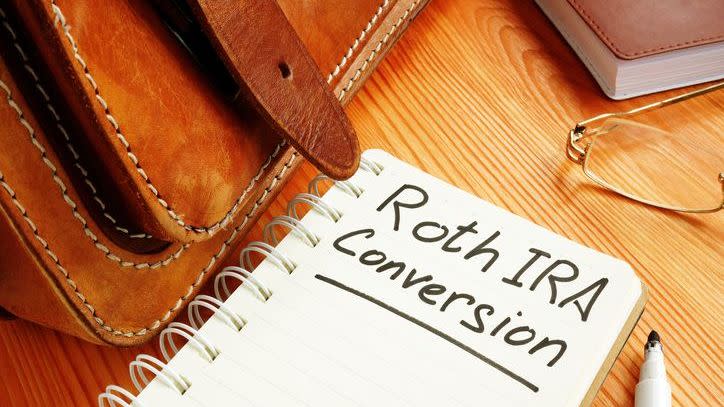People with Roth IRAs generally must wait five years before withdrawing earnings from their accounts.
But the devil is in the details, and for this particular line, getting those details can be surprisingly difficult. For starters, the IRS has three different five-year rules that apply to Roth IRAs. One of them, the conversion rule, seems self-contradictory. The IRS does not publish clear instructions about these rules. And every outlet that writes about this topic seems to provide slightly different information.
In other words, don’t blame yourself if you’re confused. This one is very confusing, which is why it can be so helpful to work with a financial advisor who understands the ins and outs of the IRS rules. Contact a fiduciary advisor today.
Let’s say you’re 70 years old and your required minimum distributions (RMDs) start in three years. You want to avoid RMDs by rolling over your $900,000 pre-tax savings into a Roth IRA. How is the five-year rule applied?
The three five-year rules


There are three different versions of the five-year rule, each based on how you fund or receive funding from your Roth portfolio.
1. Roth contributions
This version applies to contribution income, that is, earned income subject to the annual IRA contribution limit. You must wait five years from the time you first fund a Roth account before you can take distributions from a Roth portfolio. This is a one-time rule, meaning it will not be reset for future contributions after your first.
2. Roth conversions
This version applies to converted balances, that is, assets transferred from a pre-tax portfolio. After you convert, you must wait five years before you can receive distributions from the converted funds. However, this rule does not apply to people aged 59 ½ and older.
This rule applies independently to each conversion, with the clock starting on January 1 of the year in which you perform the conversion. For example, if you made a Roth conversion on July 15, 2023, the five-year period would be from January 1, 2023 to January 1, 2028.
Keep in mind that a financial advisor can help you complete a Roth conversion, which can be especially helpful if you are not eligible to contribute directly to a Roth IRA.
Roth legacy
When you inherit a Roth portfolio, depending on your status as a beneficiary, you may be required to withdraw all assets within five years of the original owner’s death. This version applies to estates and is beyond the scope of this article.
What is a Roth IRA?
A Roth IRA is a retirement account funded with after-tax dollars. This means that you have already paid taxes on the money in the portfolio. This allows you to withdraw this money (principal and return) later in your life completely tax-free. Because the money has already been taxed, Roth IRAs are not subject to RMDs.
There are two ways to fund a Roth IRA: contributing directly to a Roth IRA and converting tax-deferred assets into Roth assets. With a premium, you invest the earned income in your portfolio up to the annual premium limit (€ 7,000 per year in 2024). In a conversion, you transfer money from a pre-tax portfolio to a Roth IRA and pay income taxes on the money. There is no limit to how often you can convert assets or in what amounts.
If you need help deciding how to divide your retirement savings between tax-deferred and Roth accounts, consider talking to a financial advisor.
What is a qualified distribution?
A qualified distribution occurs when you make a tax-free withdrawal of the income from your Roth portfolio. If your withdrawal doesn’t meet the rules for a qualified distribution, the IRS will charge you both income tax and a 10% penalty. Since you’ve already paid taxes on the principal of the portfolio, you can withdraw it at any time (obviously this only applies to direct contributions, not Roth conversions).
To qualify for a qualified distribution, you generally must:
-
Be 59 ½ years of age or older OR have a qualifying disability OR meet the first-time home buyer requirement, AND
-
Meet the portfolio’s five-year rule
The five-year rule for conversions


Keep in mind that the five-year conversion rule applies to money you transfer from a pre-tax account to a Roth IRA.
To summarize, you must wait at least five years from the time you convert the money before you can take a qualified distribution from those assets. This rule applies separately to each conversion. In practice, any time you convert assets into a Roth IRA, you must treat that conversion as its own segment of assets, which must remain in place for five years.
However, the conversion rule does not apply if you are 59 ½ years or older. In that case, you can take qualified distributions at any time and avoid the 10% early withdrawal penalty.
Here’s the rule that applies to our hypothetical example above: You’re 70 years old and will soon have RMDs. You want to convert your pre-tax portfolio of $900,000 to a Roth IRA to avoid RMDs. If you’re in a similar situation and need help planning your Roth conversions, consider talking to a financial advisor.
Here are two conversion options and how the five-year rule would come into play:
Lump sum conversion at age 70+
In this case, you convert all €900,000 at once. This would generate about $288,000 in federal taxes, leaving you with about $612,000 in your Roth IRA.
You are free to immediately receive qualified distributions from this portfolio. Even if it has been less than five years, you are older than 59 ½ years and the conversion rule does not apply.
Staggered conversions from age 70
In this case you can convert €300,000 per year. This may allow you to avoid RMDs and reduce your taxes at the same time. You could end up paying about $72,000 per year, or $216,000 in total federal taxes on this conversion.
You are free to immediately receive qualified distributions from this portfolio and its income. Even if it was less than five years ago, you are again older than 59 ½ and the conversion rule does not apply.
In short
If you plan to do a Roth conversion to avoid RMDs, you need to understand how the different five-year rules work. One of those rules specifically pertains to Roth conversions, requiring you to wait five years before you are eligible to withdraw converted funds tax- and penalty-free. Fortunately, if you are 59.5 years or older, this five-year rule does not apply.
Tips for managing your RMDs
-
Before you make any decisions about your required minimum distributions, calculate what they are. To help you with this, SmartAsset has built an RMD calculator that estimates how much your first required withdrawal will be and when it is due.
-
A financial advisor can help you create a comprehensive retirement plan that takes your RMDs into account. Finding a financial advisor does not have to be difficult. SmartAsset’s free tool matches you with up to three vetted financial advisors serving your area, and you can have a free introductory meeting with your advisors to decide which one you think is right for you. If you’re ready to find an advisor who can help you achieve your financial goals, get started now.
Photo credit: ©iStock.com/brizmaker, ©iStock.com/designer491, ©iStock.com/SDI Productions
The post My RMDs start soon, so I want to convert $900,000 to a Roth, but I’m getting conflicting information about having to wait 5 years to use the money appeared first on SmartReads from SmartAsset.





